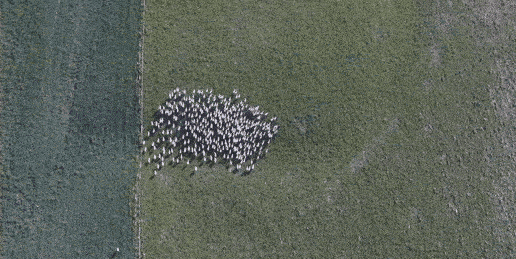Controlling Noisy Herds
a centuries old farming practice informs our knowledge of Control theory
Three dogs herding sheep in the field. Source.
Animals in nature form noisy, Stochastic collectives
Birds, bugs, fish, sheep, and many other organisms form collectives that can provide benefits to the individual, such as protection from predators. How does the movement of each individual preserve the collective swarm?
When a predator attacks a group, individuals at the edge selfishly move towards the center of the herd to save themselves. This behavior is called the selfish herd behavior. Humans exploit this selfish herd behavior to manage farm animals like sheep and cattle with the help of herding dogs. In our study, we utilize the predator response of sheep to uncover the individual level decisions that govern the movement of an entire herd.
The historical timeline of animal herding with the help of dogs.
Dogs have been utilized throughout history by man to in agriculture, forming a historical and generational relationship spanning thousands of years.
How can a dog control chaos?
Your dog may be a harbinger of chaos in your home, but sheepdogs have been bred for centuries to control large, noisy groups in the field. We introduce to you the man-made relationship between dog and sheep, trained and bred by shepherds for centuries across the world. How good is a dog at controlling sheep, and how does the shepherd know when to instruct the dog? To answer this, we take a look at sheepdog trials.
A photo of Old Hemp, a stud dog known to be the father of modern Border Collie, and a photo of the first international sheepdog trials at Alexandra Palace in London in 1876.
A dog herding sheep in a sheepdog trial. Link to source
In sheepdog trials, dogs and their handlers are judged for their ability to not only herd a group of sheep but also split them on demand. We talked to professional dog trainers and sheepdog trials. Depending on the age, breed and size, the response of the sheep to the dog threat may vary. In the shepherding community, sheep are termed as light or heavy depending on their response. Light sheep are highly responsive to the dogs action whereas heavy sheep are more stubborn and often ignore the dog’s threat. The competitions use only 4 to 5 sheep to test the dog since small groups of sheep are the most difficult to control.
“Light” sheep. Credit: Luke Freeman on Flickr
“Heavy” sheep. Credit: Larry James on Flickr
Our study examines the fine level control and decisions by the dog and feedback from the sheep to create a model that informs our understanding of controlling noisy systems. We investigate how these individual responses can scale up to managing huge swarms.
Sheepdog trials. Image source.
Two step process of herding and two step process of shedding.
Major questions
How can sheep behavior in small groups inform us of multi-agent decision-making?
How do the dogs respond to and analyze sheep behavior to control a noisy collective?
Can the dog’s strategy inform how we control stochastic systems?
Is indecisiveness useful?
What we’ve discovered
Quantifying Sheep Herd Behavior: Why Small Herds are Hard to Control
When a solitary sheep encounters a dog, it runs away. However, when in large groups, sheep tend to move towards the center of the herd to avoid the dog (selfish herd behavior). In small groups, sheep get confused whether they want to run away as solitary or move as a group. Hence, they randomly switch between these two behaviors making these small groups highly unpredictable and difficult to control. We developed a simplified model to quantify the noisy behavior of sheep, and extended our model to propose a unified phase diagram for the behavior of the sheep as a function of the group size and stimulus (threat from dog).
Herding and Splitting of Light and Heavy Sheep
Our model was not only able to quantitatively describe the noisy behavior of the sheep in small groups, but also was able to predict the behavior of light and heavy sheep in presence of a dog. Using our model to analyze sheep behavior during herding and splitting, we predicted that while light sheep are easier to herd, heavy sheep are easy to split. We verified these predictions with observations from sheepdog trial competitions.
How Sheepdogs Control Sheep Decision Making
Now that we know how sheep move, we investigated how the dogs control noisy herds of sheep. In both herding and splitting, the dog only moves the sheep when they are in the preferred orientation. The dog achieves this by performing the tasks in two stages. In the first stage, it slowly moves towards the sheep to nudge them to the preferred orientation without inducing movement. Once the sheep are in the preferred orientation, the dog applies a high pressure forcing the sheep to move.
Using Indecisiveness as a Control Strategy in Artificial Systems
To evaluate the role of indecisiveness, we developed the Indecisive Swarm Algorithm (ISA), where sheep-like agents scholastically switch inputs between a controller, such as a dog, or another agent such as the nearby sheep. When compared to Averaging Swarm Algorithms (ASA) and the Leader Follower Swarm Algorithm (LFSA), the ISA agents could successfully follow a path without large pressure from the controller, whereas ASA and LFSA agents would deviate significantly. Thus, indecisiveness proves useful for controlling noisy collectives such as sheep or robot swarms, reducing effort for simple tasks like following a track, and introducing capabilities for complex tasks, like herding or splitting.
Read the papers
Controlling noisy herds, arXiv (2024)














